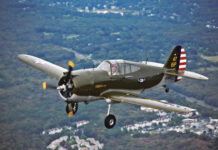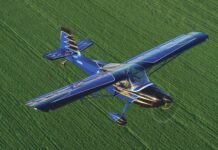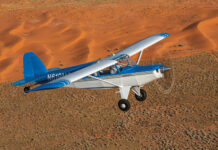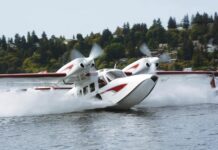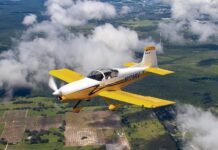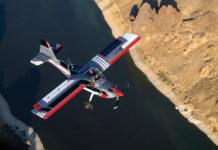When we last took a look at the Bearhawk LSA (KITPLANES January 2013), the prototype was flying, plans were available for scratch building, and kits were beginning to ship. Nevertheless, designer Bob Barrows was still finding ways to improve the design. Performance was good with a 65-horsepower Continental engine, but he knew it was inevitable that some builders would ask for a larger powerplant. (Imagine that!) Anticipating their requests, he was already working on a modified Continental C85-8 engine that produces a little over 100 hp, (Barrows estimates 105 hp, but it’s never been dyno tested.)
With the new engine installed and a McCauley 74-inch diameter, 41-inch propeller on the nose, it seemed like the perfect time to flight-test the Bearhawk LSA. I contacted Barrows and we agreed to meet at Virginia Tech Airport in Blacksburg, VA, which has both a paved and turf runway.
It’s All in the Cards
In the FBO pilot-briefing area, Barrows and I discussed the test card for the evaluation flights. For the first flight, I asked Barrows to demonstrate a takeoff and landing from the front seat, and I would do the climb, cruise, stall, and flying qualities evaluations from the rear. For the second flight, we would switch seats and I would conduct the takeoff and landing, stability, and flying qualities evaluations from the front (while Barrows clenched his teeth in the rear). Barrows agreed, so we walked out to take a good look at his most recent design.

No gyros or glass in this panel! The Bearhawk LSA is for simple flying off of grass strips. If you need a map, fold one up and slip it under your thigh.
Like at First Sight
At first glance, the Bearhawk LSA looks like a typical rag-wing taildragger. But closer inspection reveals it actually has a fabric-covered tail and fuselage, with metal wings.
There certainly is something different about the wings; they don’t have the expected Piper, Aeronca, etc. leading edge and cross section. Barrows said they were Riblett 30-613.5 airfoils, with a maximum thickness at 30% chord, 6% camber, and a maximum thickness of 13.5%. I wondered what effect the airfoil would have, but I should have figured it out. The Bearhawk Patrol has the same airfoil with a 4% camber, which gives it an exceptional cruise speed.
The 34-foot wingspan and sizeable fabric-covered ailerons near the wing tips suggested we’d see some adverse yaw. But the large vertical stab and rudder indicated it had been anticipated.
The flapless wings were covered with 0.016-inch 2024T3 aluminum skin.Barrows indicated, however, that production aircraft will have 0.020 wing skins to provide better airfoil continuity and ease of construction.
The overall lines are aerodynamically pleasing and the 21-inch tires give the Bearhawk LSA a semi-tundra look. The long fuselage connected to a large tail almost guarantees good longitudinal and directional stability, and an ample CG range.
The horizontal stabilizer is a bit unusual for this class of aircraft. Rather than the simple slab used on similar designs, it has a symmetrical airfoil cross section for increased pitch control.
Both landing gear systems were designed by Barrows. The tailwheel is a full-swivel/steerable arrangement, and the mains are scaled-down spring/hydraulic shock units that have been proven in rough-terrain environments on the previous Bearhawks. The mainwheels, hydraulic disc brakes and tires were obtained from Matco.
Cockpit entry required a small step for Barrows and a giant leap for me. I think a step would have been nice.
The functional cockpit felt roomier than a Cub or Champ, with a normal size pilot seat in front, with fore and aft adjustment capability, and a wide rear seat (Champ or PA-12 like) with quite-adequate legroom at both locations. Cockpit visibility is good from either seat, with excellent visibility over the nose from the front.

It doesn’t get much simpler than a wooden knob on a single throttle lever. The Bearhawk LSA is flying at its purest.
Flight controls consist of stick and rudder, front and rear, with toe brakes provided for the front seat, which is the solo pilot position. The ailerons and rudders are cable controlled, and the elevator is controlled by pushrods. A single pitch trim control is located overhead and is reachable from the front and rear seats. There was some static friction in the elevator that I considered slightly excessive for a pushrod system. Cockpit control motion felt normal, with no interference with legs, seats, panel, or other typical motion limiters.
Engine controls consist of throttles on the left panels, mixture and carb heat push-pull controls on the left of the instrument panel, and a magneto switch on the right. The P-leads and spark plug leads are the only electrical wires in the prototype, however, a full electrical system is available as an option to builders.
Fuel sight guages are placed at the right and left wingroot locations, and the fuel switch is a right/left/both/off switch on the center front cockpit floor. The instrument panel is completed by an airspeed indicator, a non-precise altimeter (I love it), a wet compass, oil pressure/temperature indicator, and a tachometer.
There are large flop-up windows on both sides of the cockpit, and the one on the right is matched with a hinge-forward door for cockpit entry.
All in all, this was my kind of cockpit. Glass was minimal, and what was there was round, with a maximum of 3.25-inch diameter, no buttons to push, just simply stuff required to fly the airplane and no more. Not much excuse for heads-down flying in this airplane.

Bob Barrows designed the Bearhawk LSA for a gross weight of 1500 pounds with utility category strength. Operating at the LSA maximum of 1320 pounds increases performance and provides an extra margin of safety.
Let’s Fly!
For the first flight, Barrows conducted the hand-powered start, while I watched from the back (with no brakes). The taxi-out on the paved taxiway appeared effortless, and the ride was very smooth on the 21-inch tires. Runup consisted of a mag check and a very short takeoff checklist: final check of fuel valve position, takeoff trim set, and visual traffic check.
The Takeoff: Brace Yourself!
My RVs give a pretty good push from the back of the seat on takeoff; I didn’t expect much from a fixed-pitch, 105-hp LSA. Wrong. I’d intended to take a peek over Barrows’ shoulder at the lift-off speed, but the rapid 200-foot takeoff roll, followed by a steep 60 mph IAS climbout precluded a peek at much of anything. I would estimate the initial climb was in excess of 1000 fpm. I thought LSAs were supposed to be sissy airplanes.
The Climb: More of the Same
Barrows set up the climb at 2600 rpm and full throttle (still not 100% power; the fixed pitch prop thing) and 8o mph IAS. At this point, he gave me control of the airplane. I varied the speed between 60 and 80 mph IAS and began to make test inputs. From the rear, visibility was good out the sides and below, but S-turns were required for forward visibility, due to rather steep climb attitude, even at 80 mph IAS.
Pitch trim was quite adequate, but not oversensitive. Control harmony was well balanced; neither pitch nor roll forces dominated maneuvering tasks. The pitch friction I felt on the ground was not noticeable in flight. A quick check of longitudinal static and dynamic stability indicated good, positive stability.
Cruise Flight: How fast can it go on 80 hp?
Leveling at 5000 feet msl, where the outside air temperature was 0 F, the throttle was set at 2600 rpm, which produced an estimated 65% power (68 hp), burning approximately 6 gph of fuel. The estimated 65% figure was later changed to 76% (80 hp) as a very conservative estimate for comparison with other LSA designs.
GPS groundspeed into the wind was 95 knots, downwind was 107 knots, for an average (no wind) groundspeed, and true airspeed of 101 knots (117 mph). During the speed checks, Barrows was showing an IAS of 115 mph. I later calculated the CAS as 110 mph, so at this speed, the aircraft ASI was indicating about 5 mph high. Looking back, I wish I’d calibrated the ASI at near stall speed, because it was impressively low.
Cruise Stability
Pitch trim was positive with comfortable sensitivity. Control harmony was well balanced with forces slightly higher than climb values. There was no noticeable friction in any axis. Pitch velocity and acceleration gradients were positive and the presence of a phugoid further verified positive pitch static stability. The short-period frequency was moderately high, which indicated a strong level of pitch static stability.
The directional axis was strongly stable, with a well-damped Dutch roll at moderate frequency and high roll-to-yaw ratio. Rudder inputs showed a high level of dihedral effect. The roll axis had a high level of roll damping and a neutral spiral mode.
Aileron inputs resulted in significant adverse yaw, about the level expected for aircraft of this configuration. The adverse yaw could be well controlled with coordinated rudder and aileron inputs. Attitude, heading, altitude, and airspeed were easily controlled, and rudder compensation was required for aileron inputs.
The bottom line? The Bearhawk LSA is quite stable in cruise flight. Once you get the airplane in the desired attitude it’ll stay there. Just don’t expect to keep your feet on the floor during maneuvering.

The horizontal tail displays its sophistication—if you look closely, you’ll see a symmetrical airfoil shape, not just a flat slab as on an early Cub.
Slow Flight and Stalls
Still at 5000 feet. I slowed the baby Bearhawk to 50 mph IAS and went through the same stability checks as at cruise. Stability was still good in all axes, frequencies a little lower, controls a little softer but still quite stable, and well ahead of an aft limit. Adverse yaw was slightly more pronounced, but still quite controllable.
The aircraft stalled at 28 to 30 mph IAS with a straight-ahead break and adequate stall warning. Only relaxation of back pressure was necessary for recovery. I attempted some accelerated stalls, but they were difficult to achieve, requiring very aggressive pitch inputs. The break was slightly left (in a left turn), again requiring only a reduction in back pressure for recovery.
The speed was then set to 40 mph IAS and quite aggressive steep turns were conducted, requiring only normal piloting techniques (i.e. coordinated aileron and rudder), and power to control speed. At 40 to 50 mph IAS, full-rudder sideslips were well controlled, with no tendency to depart.
About That Stall Speed
Conventional airspeed indicators typically have linear (straight line) calibration curves, down to about 50 to 60 mph. In-flight calibration at speeds lower than that is difficult, due to proximity to the stall. However, we can expect the calibration (correction for accuracy) to become nonlinear (a term engineers use when they have no idea) somewhere below 50 mph IAS.
There’s only one way to tell for certain if one airplane can fly slower than another: Fly side by side and see who stalls first. That being beyond the scope of this effort, I can state, in a nonlinear fashion, the stall speed of the Bearhawk LSA is very close to 30 mph CAS.
Approach and Landing: (How to do it Without Flaps)
Barrows demonstrated approach and landings with a touch and go on the paved runway, and a full stop landing on the turf. Downwind was flown at 60 mph IAS, slowing to 50 mph IAS in the approach turn, and further slowing to 40 mph IAS on final. To achieve a reasonable glideslope at these speeds required idle power and a full rudder sideslip.
For those who have never used this technique, it may appear rather radical at first glance, but it’s really quite normal—and necessary—for this type of aircraft, equipped with flaps or not. The airplane was designed to handle this flight regime, and it will not stall/spin/crash and burn; remember, we checked it out at 5000 ft. and survived.
For both landings, touchdown was at 28 to 30 mph IAS, at the desired point on the runway, and at a reasonable sink rate. Barrows made it look easy. I’d soon find out if it really was.
Trying the Front Seat
Barrows once again performed his starting magic (somewhat simpler this time, as I could hold the brakes from the front seat) for flight number two. Taxiing the LSA was straightforward, with excellent tailwheel steering. Brakes were required only for sharp turns and stopping. Runup was a conventional mag check, followed by completion of the takeoff checklist.
The application of full throttle was followed by immediate acceleration. Using a three-point technique, liftoff occurred at 30 mph IAS after a roll on the paved runway of less than 200 feet. A steep deck angle was required to maintain the 60 mph IAS initial climb speed.
Geriatric Pattern and Landings
The short climb to the 1000 feet agl pattern altitude took less than a minute, and a left pattern was established with a 60 mph IAS downwind leg. The 50-pound increase in gross weight (due to additional fuel) and the aft shift of the CG to 30.6% (due to Barrows and I switching seats) had no apparent effect on flying qualities.
I suspect the aft CG limit might be conservative. Barrows agrees, adding that he has yet to complete flight testing to determine the final aft limit figure.
Starting the approach turn, I slowed the aircraft to 50 mph IAS. At this point, it was obvious my downwind leg was rather close abeam for a 1000 ft. pattern. A rather aggressive slip was initiated about halfway around the approach turn, and continued until the desired glide path was achieved on short final, where the airspeed had decelerated to 40 mph IAS. It wasn’t difficult to correct glide path, control airspeed deceleration, and line up with the runway, while executing a near-full-pedal sideslip. Who needs flaps?
The LSA touched down at the desired point; however, the sink rate was higher than desired. I knew there would be less ground effect with this high wing configuration than with the low wing RVs I’d been flying, but it was still a little less than expected. Barrows seemed unconcerned (perhaps he didn’t expect much anyway), and we executed a touch and go, followed by another short climb to 1000 ft. agl.
The second, and final, approach and landing was set up with the same airspeeds, but with a slightly wider downwind and slightly longer final leg. As a result, the slip was delayed until final approach, the touchdown was on the desired spot, and a slight addition of power just prior to touchdown resulted in a smooth touchdown at 28 to 30 mph IAS.
The turf alongside Runway 12 was rough enough to damage an RV with its 5.00×5 tires, but the LSA, with its 21-inch tires, made turf operations quite comfortable. A climb up a rather steep berm was required to reach the paved taxiway, and the LSA handled it quite well.
Will Production Models Perform Like the Prototype?
In order to meet the requirements of most builders, the Bearhawk LSA will require: a heater; an entry step; an electrical system, including starter and alternator; and basic avionics. Using lightweight components, these additions would add about 40 pounds to the weight of the prototype. However, a production Bearhawk LSA of that weight would still be within LSA weight limits, and with a composite prop and standard-size tires, would probably be within 20 pounds of the prototype. It seems reasonable to expect that a production version with the above will perform like the prototype.
For builders who want a bush plane that meets LSA requirements, the Bearhawk LSA is an attractive option. It has equal or better performance than many similar designs, particularly in cruise. The downside? All airplanes are compromises—and nothing that looks like a Piper Cub will ever be easy to get in and out of. Suck it up.

![]()
Chuck Berthe is a retired Naval Aviator, civilian Test Pilot, and Aeronautical Engineer with ATP, CIFI, Helo, A&P ratings, and two Repairman Certificates. He has logged 16,600 pilot hours, and is an Associate Fellow in the Society of Experimental Test Pilots.













